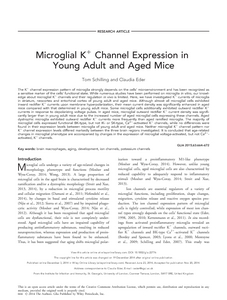Schilling, T; Eder, C
(2015)
Microglial K(+) channel expression in young adult and aged mice.
Glia, 63 (4).
pp. 664-672.
ISSN 1098-1136
https://doi.org/10.1002/glia.22776
SGUL Authors: Eder, Claudia Schilling, Tom
![[img]](https://openaccess.sgul.ac.uk/107374/1.hassmallThumbnailVersion/Microglial_K%2B_channel_expression_in_young_adult_and_aged_mice.pdf)  Preview |
|
["document_typename_application/pdf; charset=binary" not defined]
Published Version
Download (542kB)
| Preview
|
Abstract
The K(+) channel expression pattern of microglia strongly depends on the cells' microenvironment and has been recognized as a sensitive marker of the cells' functional state. While numerous studies have been performed on microglia in vitro, our knowledge about microglial K(+) channels and their regulation in vivo is limited. Here, we have investigated K(+) currents of microglia in striatum, neocortex and entorhinal cortex of young adult and aged mice. Although almost all microglial cells exhibited inward rectifier K(+) currents upon membrane hyperpolarization, their mean current density was significantly enhanced in aged mice compared with that determined in young adult mice. Some microglial cells additionally exhibited outward rectifier K(+) currents in response to depolarizing voltage pulses. In aged mice, microglial outward rectifier K(+) current density was significantly larger than in young adult mice due to the increased number of aged microglial cells expressing these channels. Aged dystrophic microglia exhibited outward rectifier K(+) currents more frequently than aged ramified microglia. The majority of microglial cells expressed functional BK-type, but not IK- or SK-type, Ca(2+) -activated K(+) channels, while no differences were found in their expression levels between microglia of young adult and aged mice. Neither microglial K(+) channel pattern nor K(+) channel expression levels differed markedly between the three brain regions investigated. It is concluded that age-related changes in microglial phenotype are accompanied by changes in the expression of microglial voltage-activated, but not Ca(2+) -activated, K(+) channels.
| Item Type: |
Article
|
| Additional Information: |
© 2014 The Authors. Glia Published by Wiley Periodicals, Inc. This is an open access article under the terms of the Creative Commons Attribution License, which permits use, distribution and reproduction in any medium, provided the original work is properly cited. |
| Keywords: |
aging, brain macrophages, development, ion channels, potassium channels, brain macrophages, aging, development, ion channels, potassium channels, Neurology & Neurosurgery, 1109 Neurosciences |
| SGUL Research Institute / Research Centre: |
Academic Structure > Infection and Immunity Research Institute (INII) |
| Journal or Publication Title: |
Glia |
| ISSN: |
1098-1136 |
| Language: |
eng |
| Dates: |
| Date | Event |
|---|
| April 2015 | Published |
|
| PubMed ID: |
25472417 |
| Web of Science ID: |
WOS:000349973900010 |
 |
Go to PubMed abstract |
| URI: |
https://openaccess.sgul.ac.uk/id/eprint/107374 |
| Publisher's version: |
https://doi.org/10.1002/glia.22776 |
Statistics
Item downloaded times since 23 Apr 2015.
Actions (login required)
 |
Edit Item |



